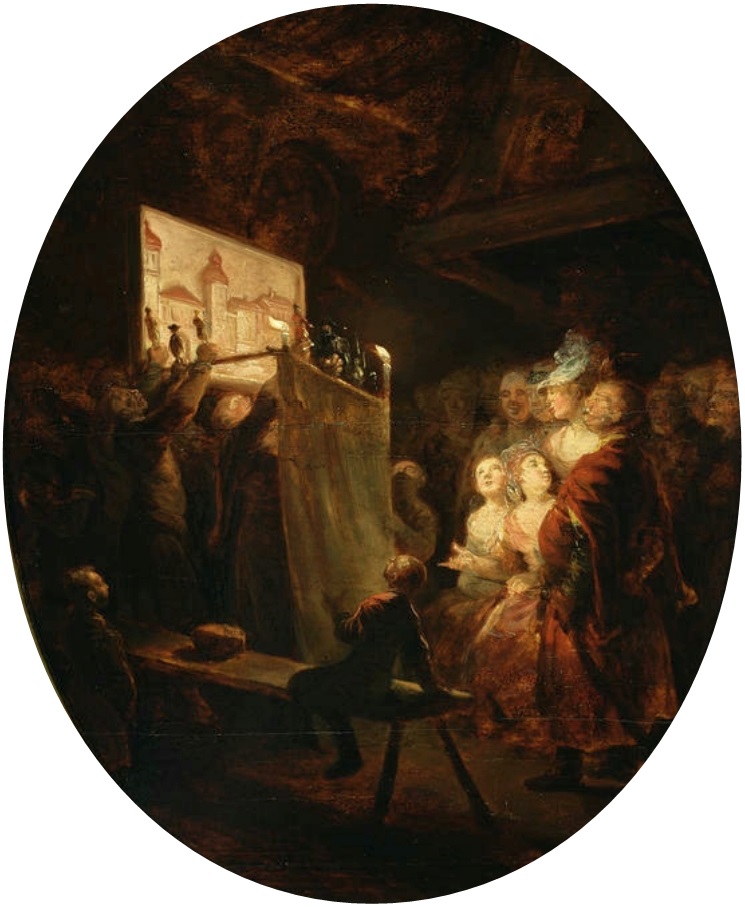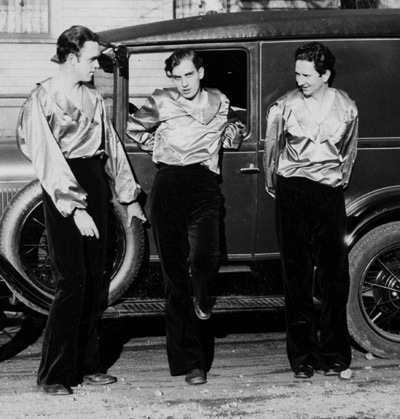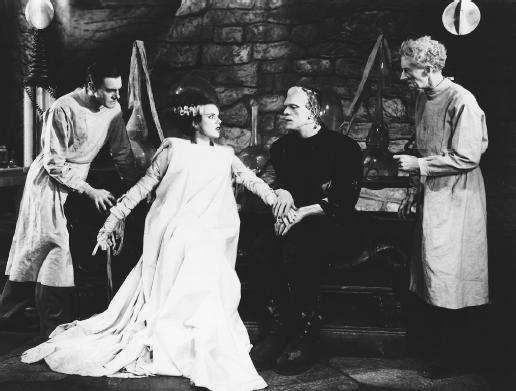|
Turnabout Theatre
The Turnabout Theatre was a company of marionette puppeteers who performed in Hollywood from 1941 through 1956. The company's shows began with marionette performances, and concluded with a revue. The name of the theater derives in part from the fact that the theater seats were former streetcar seats that could be turned to face a puppet stage at one end or the live revue stage at the other. Adjacent seats were labeled with humorous names (e.g., "Hot 'n Bothered," "Salt 'n Pepper," etc.), and after intermission theater-goers would "turn about" to see the show continued at the opposite end of the house. The Theater originated with a group known as the Yale Puppeteers composed notably of Forman Brown, Harry Burnett, and Richard (Roddy) Brandon. Many artists, some quite well known or soon to be well known also participated, including Odetta and Elsa Lanchester, whose brother Waldo Lanchester was a famous puppeteer in the UK. The history of the theater is documented in the film, ''T ... [...More Info...] [...Related Items...] OR: [Wikipedia] [Google] [Baidu] |
Marionette
A marionette (; french: marionnette, ) is a puppet controlled from above using wires or strings depending on regional variations. A marionette's puppeteer is called a marionettist. Marionettes are operated with the puppeteer hidden or revealed to an audience by using a vertical or horizontal control bar in different forms of theatres or entertainment venues. They have also been used in films and on television. The attachment of the strings varies according to its character or purpose. Etymology In French, ''marionette'' means "little Mary". In France, during the Middle Ages, string puppets were often used to depict biblical events, with the Virgin Mary being a popular character, hence the name. In France, the word ''marionette'' can refer to any kind of puppet, but elsewhere it typically refers only to string puppets. History Ancient times Puppetry is an ancient form of performance. Some historians claim that they predate actors in theatre. There is evidence that they we ... [...More Info...] [...Related Items...] OR: [Wikipedia] [Google] [Baidu] |
Hollywood, Los Angeles
Hollywood is a neighborhood in the Central Los Angeles, central region of Los Angeles, California. Its name has come to be a metonymy, shorthand reference for the Cinema of the United States, U.S. film industry and the people associated with it. Many notable film studios, such as Columbia Pictures, Walt Disney Studios (division), Walt Disney Studios, Paramount Pictures, Warner Bros., and Universal Pictures, are located near or in Hollywood. Hollywood was incorporated as a municipality in 1903. It was Merger (politics), consolidated with the city of Los Angeles in 1910. Soon thereafter a prominent film industry emerged, having developed first on the East Coast. Eventually it became the most recognizable in the world. History Initial development H.J. Whitley, a real estate developer, arranged to buy the E.C. Hurd ranch. They agreed on a price and shook hands on the deal. Whitley shared his plans for the new town with General Harrison Gray Otis (publisher), Harrison Gray Otis, ... [...More Info...] [...Related Items...] OR: [Wikipedia] [Google] [Baidu] |
Revue
A revue is a type of multi-act popular theatrical entertainment that combines music, dance, and sketches. The revue has its roots in 19th century popular entertainment and melodrama but grew into a substantial cultural presence of its own during its golden years from 1916 to 1932. Though most famous for their visual spectacle, revues frequently satirized contemporary figures, news or literature. Similar to the related subforms of operetta and musical theatre, the revue art form brings together music, dance and sketches to create a compelling show. In contrast to these, however, revue does not have an overarching storyline. Rather, a general theme serves as the motto for a loosely-related series of acts that alternate between solo performances and dance ensembles. Owing to high ticket prices, ribald publicity campaigns and the occasional use of prurient material, the revue was typically patronized by audience members who earned more and felt even less restricted by middle-class ... [...More Info...] [...Related Items...] OR: [Wikipedia] [Google] [Baidu] |
Forman Brown
Forman Brown (January 8, 1901 – January 10, 1996) was one of the world's leaders in puppet theatre in his day, as well as an important early gay novelist. He was a member of the Yale Puppeteers and the driving force behind Turnabout Theatre. He was born in Otsego, Michigan, in 1901 and died in 1996, two days after his 95th birthday. Brown briefly taught at North Carolina State College, followed by an extensive tour of Europe. Forman's Yale Puppeteers, which he established upon graduating from University of Michigan (class of 1922), opened a puppet theatre in Los Angeles in 1941 (the Turnabout Theater) that attracted celebrity attention and support from some of Hollywood's biggest names, e.g., Greta Garbo, Colleen Moore, Marie Dressler, Mary Pickford and Douglas Fairbanks, as well as other notable figures including Albert Einstein and Aimee Semple McPherson. Brown wrote all the songs and sketches for the troupe's productions. Regular performers included Elsa Lanchester an ... [...More Info...] [...Related Items...] OR: [Wikipedia] [Google] [Baidu] |
Harry Burnett
Harry Burnett (January 6, 1901May 28, 1993) was the designer of the Yale Puppeteers. He was also a mask creator. In ''Better Angel'', Forman Brown's early gay novel, he is Derry. Biography Harry Burnett was born on January 6, 1901, the son of Noble Burnett, a dry goods store owner, and Rose Clark. Advertising executive Leo Burnett was his brother and his nephew is Dan Bessie, who, in the film ''Turnabout: the Story of the Yale Puppeteers'' documented the history of the Yale Puppeteers. In 1923 Harry Burnett, his cousin Forman Brown, and this latter partner, Richard Brandon, formed a group of puppeteers while attending University of Michigan. Forman Brown was the writer and Harry Burnett the designer. The group continued when they moved to Yale University and became the Yale Puppeteers. An early work included a production of ''Bluebeard'' designed by Norman Bel Geddes. In the 1930s the company performed in their own puppet theatre in East 40th Street in Manhattan. In 1933 they ... [...More Info...] [...Related Items...] OR: [Wikipedia] [Google] [Baidu] |
Odetta
Odetta Holmes (December 31, 1930 – December 2, 2008), known as Odetta, was an American singer, actress, guitarist, lyricist, and a civil rights activist, often referred to as "The Voice of the Civil Rights Movement". Her musical repertoire consisted largely of American folk music, blues, jazz, and spirituals. An important figure in the American folk music revival of the 1950s and 1960s, she influenced many of the key figures of the folk-revival of that time, including Bob Dylan, Joan Baez, Mavis Staples, and Janis Joplin. In 2011 ''Time'' magazine included her recording of "Take This Hammer" on its list of the 100 Greatest Popular Songs, stating that "Rosa Parks was her No. 1 fan, and Martin Luther King Jr. called her the queen of American folk music." Biography Early life and career Odetta was born Odetta Holmes in Birmingham, Alabama, United States. Her father, Reuben Holmes, had died when she was young, and in 1937 she and her mother, Flora Sanders, moved to Los Angeles. ... [...More Info...] [...Related Items...] OR: [Wikipedia] [Google] [Baidu] |
Elsa Lanchester
Elsa Sullivan Lanchester (28 October 1902 – 26 December 1986) was a British-American actress with a long career in theatre, film and television.Obituary ''Variety'', 31 December 1986. Lanchester studied dance as a child and after the First World War began performing in theatre and cabaret, where she established her career over the following decade. She met the actor Charles Laughton in 1927, and they were married two years later. She began playing small roles in British films, including the role of Anne of Cleves with Laughton in ''The Private Life of Henry VIII'' (1933). Her success in American films resulted in the couple moving to Hollywood, where Lanchester played small film roles. Her role as the title character in ''Bride of Frankenstein'' (1935) brought her recognition. She played supporting roles through the 1940s and 1950s. She was nominated for the Academy Award for Best Supporting Actress for ''Come to the Stable'' (1949) and ''Witness for the Prosecution'' ( ... [...More Info...] [...Related Items...] OR: [Wikipedia] [Google] [Baidu] |
Waldo Lanchester
Waldo Sullivan Lanchester (6 May 1897 – 15 December 1978) was a British puppeteer who founded the Lanchester Marionettes (1935–1962), a puppet theatre that was based in Malvern, and later in Stratford-upon-Avon. He wrote a book on the revival of puppeteering and commissioned George Bernard Shaw to write his last completed play ''Shakes versus Shav'' in 1949. In 1952, Donald W. Seager wrote that "Waldo Lanchester has consistently been associated with all that is best in the puppet theatre." Archibald Henderson called him "England's greatest puppetmaster." Early life Lanchester was the son of James "Shamus" Sullivan (1872–1945) and Edith "Biddy" Lanchester (1871–1966). His younger sister was the actress Elsa Lanchester. Two of the earliest puppets he created were named "Baldo and Belsa", the pet names of himself and his sister Elsa. The family were considered Bohemian, and refused to legalise their union in any conventional way to satisfy the era's conservative society. ... [...More Info...] [...Related Items...] OR: [Wikipedia] [Google] [Baidu] |
Lost Gay Novels
''Lost Gay Novels'' is a 2003 reference guide written by Anthony Slide that provides commentary on 50 works of gay literature published between 1900 and 1950 that Slide found to be not well-known by late 20th and early 21st-century audiences. Summary ''Lost Gay Novels'' provides plot summaries and reviews of 50 novels, organized alphabetically by the authors' last names. The book does not comprehensively cover gay literature from the time period, nor was it designed to be a recommended reading list, but rather covers books with different outlooks on homosexuality and gay issues and the context of their times. Most of the novels included are American, though a few are from Europe. The book also provides a discussion on the characters, and presents authors who are not normally associated with homosexuality. Covered works Impact ''Lost Gay Novels'' is notable for documenting the gay literature subculture that was active prior to the Stonewall riots. The novels discussed ... [...More Info...] [...Related Items...] OR: [Wikipedia] [Google] [Baidu] |
Leo Burnett
Leo Burnett (October 21, 1891 – June 7, 1971) was an American advertising executive and the founder of Leo Burnett Company, Inc. He was responsible for creating some of advertising's most well-known characters and campaigns of the 20th century, including Tony the Tiger, the Marlboro Man, the Maytag Repairman, United's "Fly the Friendly Skies", and Allstate's "Good Hands", and for garnering relationships with multinational clients such as McDonald's, Hallmark and Coca-Cola. In 1999, Burnett was named by ''Time'' as one of the 100 most influential people of the 20th century. Biography Leo Burnett was born in St. Johns, Michigan, on October 21, 1891, to Noble and Rose Clark Burnett. Noble ran a dry goods store and as a young man, Burnett worked with his father, watching Noble as he designed ads for the business. After high school, Burnett went on to study journalism at the University of Michigan and received his bachelor's degree in 1914. Burnett's first job after college wa ... [...More Info...] [...Related Items...] OR: [Wikipedia] [Google] [Baidu] |



.jpg)

_at_Rosehill_Cemetery%2C_Chicago.jpg)